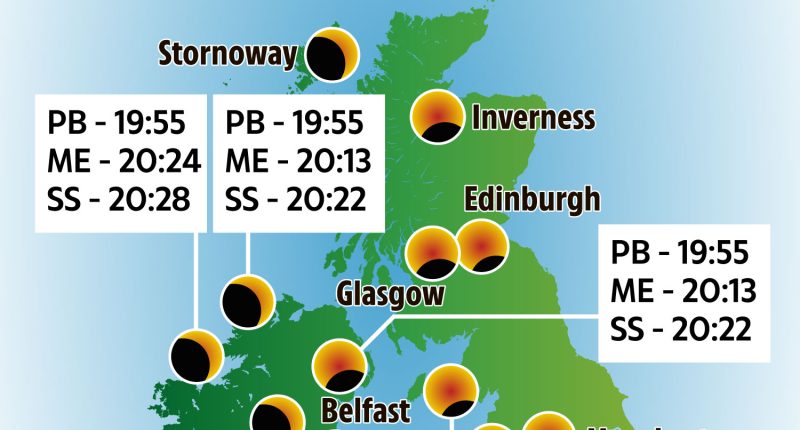A RARE solar eclipse takes places today and people are hoping to witness the spectacular event on both sides of the Atlantic.
Parts of North America will be able to observe a total eclipse, while areas of the UK and Northern Ireland will see a partial eclipse.
While the eclipse might capture most of your attention, it won’t be the only oddity to observe.
Animals, the wind and radio waves may also begin behaving strangely during the event.
A solar eclipse occurs when the Moon passes between the Sun and Earth.
It casts a shadow on Earth that either fully or partially blocks the Sun’s light in some areas, resulting in either a total or partial eclipse.
READ MORE SPACE EXPLAINERS
Read The Sun’s full solar eclipse explainer here.
From the US
Parts of the US and Canada – inside the blue line in the graphic above – will enjoy a rare total solar eclipse for the first time since 2017.
The event will begin on Mexico’s Pacific coast at around 11:07 am PDT before entering the US via Texas.
From there it will travel through Oklahoma, Arkansas, Missouri, Illinois, Kentucky, Indiana, Ohio, Pennsylvania, New York, Vermont, New Hampshire, and Maine.
Most read in Science
According to Nasa, small parts of Tennessee and Michigan will also experience the total solar eclipse – weather permitting.
Then the rare display will head into Canada through Southern Ontario, and continue through Quebec, New Brunswick, Prince Edward Island, and Cape Breton.
The eclipse is forecast to exit North America on the Atlantic coast of Newfoundland, Canada, at 5:16 pm NDT.
Nasa has more information on the exact times you will be able to see the total eclipse in your nearest city here.
From the UK and Northern Ireland
The UK and Ireland unfortunately won’t experience totality when it comes to this eclipse.
And some parts of the UK won’t see anything different at all.
With the Earth being a globe, a partial solar eclipse will only be visible from parts of the UK and Ireland as the sun sets.
You can watch the partial eclipse above Scotland in 2022 in the video above.
The amount of eclipse seen will vary by location, however, Wales, Scotland, northwest of England and the deep southwest will have the best luck.
Meanwhile, the whole of Northern Ireland and the Republic of Ireland will see the partial eclipse.
As the sun sets, the partial eclipse will appear in these regions at approximately 7:55pm GMT.
The Sky Live has more information on the exact times you will be able to catch the partial eclipse in your area here.
The next total eclipse in Europe will occur on 12 August 2026 across Greenland, Iceland and northern Spain.
How much of the Sun will be covered?
UK
- Stornoway: 22.5% coverage
- Inverness: 16%
- Edinburgh: 6.1%
- Glasgow: 11.2%
- Belfast: 17.2%
- Liverpool: 0.64%
- Manchester: 0.82%
Ireland
- Dublin: 15.4%
- Galway: 34.5%
- Cork: 19.5%
- Limerick: 20%
How to watch an eclipse
Onlookers must always observe a solar eclipse caution.
You should never look directly at the sun without proper eye protection, which includes:
- Eclipse glasses
- Solar filters
- Solar telescope
Everyone across North America will need to wear eclipse glasses or use solar filters to safely view this event – even through cameras or binoculars.
Cameras and binoculars should only be used with solar filters during the partial phases.
READ MORE SUN STORIES
You’ll need to remove the solar filters during totality if you want to capture the corona on camera.
But you must keep an eye on the time so you know when the sun is about to remerge, otherwise it could damage your camera and your eyes.













